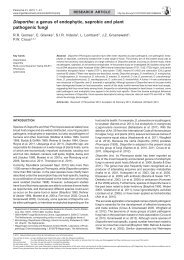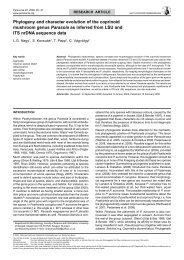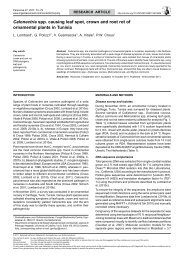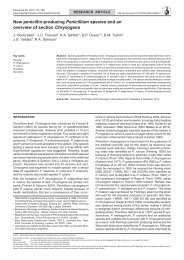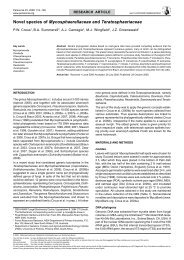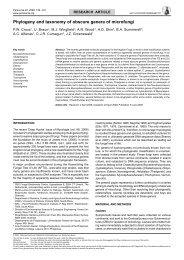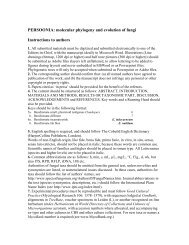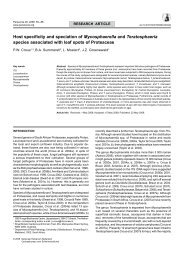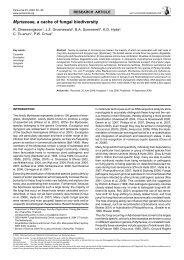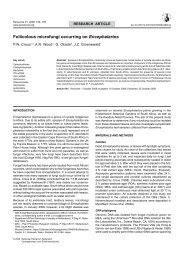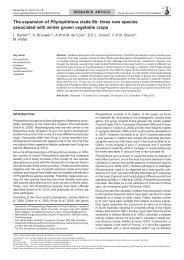Polyphasic taxonomy of the heat resistant ascomycete ... - Persoonia
Polyphasic taxonomy of the heat resistant ascomycete ... - Persoonia
Polyphasic taxonomy of the heat resistant ascomycete ... - Persoonia
You also want an ePaper? Increase the reach of your titles
YUMPU automatically turns print PDFs into web optimized ePapers that Google loves.
R.A. Samson et al.: <strong>Polyphasic</strong> <strong>taxonomy</strong> <strong>of</strong> Byssochlamys<br />
17<br />
10<br />
100<br />
100<br />
99<br />
100<br />
83<br />
92<br />
100<br />
100<br />
CBS 271.95 B. nivea<br />
CBS 133.37 B. nivea<br />
CBS 100.11 B. nivea<br />
CBS 113245 B. nivea<br />
CBS 606.71 B. nivea<br />
CBS 146.48 B. fulva<br />
CBS 135.62 B. fulva<br />
CBS 132.33 B. fulva<br />
CBS 113954 B. fulva<br />
CBS 604.71 B. nivea<br />
CBS 368.70 P. saturatus<br />
CBS 323.34 P. saturatus<br />
CBS 990.73A P. saturatus<br />
100<br />
CBS 492.84 P. saturatus<br />
CBS 696.95 B. lagunculariae<br />
CBS 374.70 B. zollerniae<br />
98<br />
CBS 371.70 P. formosus<br />
92<br />
78 CBS 113247 P. formosus<br />
CBS 990.73B P. formosus<br />
100<br />
CBS 296.93 P. formosus<br />
100 CBS 628.66 P. formosus<br />
CBS 372.70 P. formosus<br />
CBS 338.51 B. spectabilis / P. variotii<br />
89 CBS 102.74 B. spectabilis / P. variotii<br />
CBS 121581 B. spectabilis / P. variotii<br />
100<br />
CBS 101075 B. spectabilis / P. variotii<br />
CBS 110429 P. divaricatus<br />
CBS 284.48 P. divaricatus<br />
CBS 181.67 Thermoascus crustaceus<br />
98 CBS 251.55 P. saturatus<br />
CBS 373.70 B. lagunculariae<br />
100<br />
CBS 110378 B. lagunculariae<br />
CBS 370.70 P. brunneolus<br />
β-tubulin<br />
Fig. 3 One <strong>of</strong> 36 equally parsimonious trees <strong>of</strong> <strong>the</strong> analysed partial β-tubulin<br />
gene sequences (156 <strong>of</strong> <strong>the</strong> 494 characters were parsimony informative; tree<br />
length = 304, CI = 0.704, RI = 0.913, RC = 0.643, HI = 0.296).<br />
chromophore (CBS 132.33, CBS 135.62 and CBS 604.71),<br />
while <strong>the</strong> o<strong>the</strong>r group produced a series <strong>of</strong> alkaloids, some<br />
with UV spectra similar to that <strong>of</strong> paspaline (named ‘OLK’ in<br />
Table 2) and some with verrucologen-like UV spectra (called<br />
‘URT’ in Table 2) (CBS 113225, CBS 113246, CBS 113954 and<br />
TM 03.048). The ex-type culture <strong>of</strong> B. fulva was deteriorated<br />
and only produced byssochlamic acid, and none <strong>of</strong> <strong>the</strong> o<strong>the</strong>r<br />
mentioned extrolites.<br />
Some strains <strong>of</strong> B. nivea produced <strong>the</strong> full pr<strong>of</strong>ile <strong>of</strong> extrolites:<br />
patulin, mycophenolic acid, byssochlamic acid and metabolite<br />
‘OLK’ (CBS 900.70, CBS 271.95 and CBS 102192). Mycophenolic<br />
acid, patulin and byssochlamic acid and some <strong>of</strong> <strong>the</strong>ir<br />
precursors were also found by Puel et al. (2005). Byssochlamys<br />
lagunculariae produces <strong>the</strong> same overall extrolite pr<strong>of</strong>ile as<br />
B. nivea, except that patulin has not been detected in <strong>the</strong><br />
former species. Byssochlamys spectabilis and isolates with<br />
only anamorphs (P. variotii) consistently produced viriditoxin,<br />
which was earlier reported from an isolate identified as Spicaria<br />
divaricata (Jiu & Mizuba 1974). O<strong>the</strong>r unique extrolites were<br />
also produced but <strong>the</strong> structures <strong>of</strong> <strong>the</strong>se have not yet been<br />
elucidated.<br />
Table 2 Production <strong>of</strong> extrolites by Byssochlamys and Paecilomyces<br />
species 1 .<br />
Species<br />
All strains <strong>of</strong> P. divaricatus produced anthraquinones including<br />
emodin. However CBS 110429 only produced ano<strong>the</strong>r type <strong>of</strong><br />
anthraquinone, CBS 110428 and CBS 110430 produced asc<strong>of</strong>uranone.<br />
Only <strong>the</strong> ex-type culture <strong>of</strong> B. zollerniae was available<br />
for study and some unique unknown extrolites were found in this<br />
isolate. In this study, we could not confirm viriditoxin production<br />
in P. divaricatus and assume that <strong>the</strong> strain studied by Jiu &<br />
Mizuba (1974) was probably a B. spectabilis isolate.<br />
Our phylogenetic analysis showed that B. verrucosa is related to<br />
Thermoascus. Byssochlamys verrucosa produced cornexistin<br />
and/or byssochlamic acid, and also some specific unidentified<br />
extrolites only seen in this species. Thermoascus aurantiacus<br />
also produces compounds with chromophores (UV spectra)<br />
consistent with cornexistin, byssochlamic acid or similar tropolones<br />
(Frisvad unpubl. data). The production <strong>of</strong> cornexistin and<br />
byssochlamic acid demonstrates that <strong>the</strong> species chemically resemble<br />
B. fulva, B. laguncularia, B. nivea and P. divaricatus.<br />
Paecilomyces saturatus is chemically somewhat diverse. Group I<br />
produced at least one <strong>of</strong> <strong>the</strong> following extrolites: patulin, mycophenolic<br />
acid and a compound which chemically resembles<br />
aspergillic acid (CBS 251.55 T , CBS 223.52, CBS 492.84 and<br />
IBT 21716), while group II produced brefeldin A (CBS 323.34 T<br />
and CBS 990.73A) and may fit with P. mandshuricus var. saturatus.<br />
Paecilomyces formosus consistently produced variotin<br />
and related compounds, except CBS 296.93, which may be<br />
chemically close to P. saturatus (group I).<br />
Discussion<br />
Extrolites<br />
B. fulva Group I: byssochlamic acid, meriditin, ‘cycloaspeptide-like<br />
compound’<br />
Group II: byssochlamic acid, ‘OLK’, ‘URT’<br />
B. lagunculariae Byssochlamic acid, mycophenolic acid, ‘OLK’<br />
B. nivea Byssochlamic acid, mycophenolic acid, patulin, ‘OLK’<br />
B. spectabilis Viriditoxin and o<strong>the</strong>r compounds with characteristic UV<br />
spectra<br />
B. verrucosa Cornexistin and/or byssochlamic acid<br />
B. zollerniae No known extrolites, though several compounds characterized<br />
by a characteristic UV spectrum are present<br />
P. brunneolus ‘Asc<strong>of</strong>uranone-like compound’, ‘tetracycline-like compounds’<br />
P. divaricatus Cornexistin and/or byssochlamic acid, asc<strong>of</strong>uranone, emodin<br />
and o<strong>the</strong>r anthraquinones<br />
P. formosus Variotin<br />
P. saturatus Group I: patulin, mycophenolic acid or ‘aspergillic acid-like<br />
compound’<br />
Group II: brefeldin A<br />
1<br />
Byssochlamic acid, mycophenolic acid, patulin, and viriditoxin were available as au<strong>the</strong>ntic<br />
standards. Evidence for production <strong>of</strong> asc<strong>of</strong>uranone, cornexistin, meriditin and variotin is<br />
based on similar UV spectra as those reported in <strong>the</strong> literature, and <strong>the</strong>ir occurrence in<br />
species already known to produce <strong>the</strong>m. Metabolites in inverted commas have UV spectra<br />
that indicate a chemical relationship to <strong>the</strong> compounds mentioned. For example <strong>the</strong> ‘tetracycline-like<br />
compounds’ in P. brunneolus have UV spectra similar to those <strong>of</strong> tetracycline and<br />
viridicatumtoxin. ‘OLK’ and ‘URT’ are apolar indole-terpene compounds, but <strong>the</strong> chemical<br />
structure is as yet unknown. ‘OLK’ has a paspaline UV spectrum.<br />
Byssochlamys isolates were included in this study to verify <strong>the</strong><br />
connection between <strong>the</strong> anamorphic P. variotii complex and<br />
holomorphic Byssochlamys species. The genus Paecilomyces<br />
was monographed by Samson (1974) who recognised 31 species<br />
divided into two sections, Paecilomyces and Isarioidea.<br />
However, <strong>the</strong> phylogenetic analysis <strong>of</strong> <strong>the</strong> 18S rDNA demonstrates<br />
that Paecilomyces is polyphyletic across two subclasses,<br />
Sordariomycetidae and Eurotiomycetidae (Luangsa-ard et al.<br />
2004).



